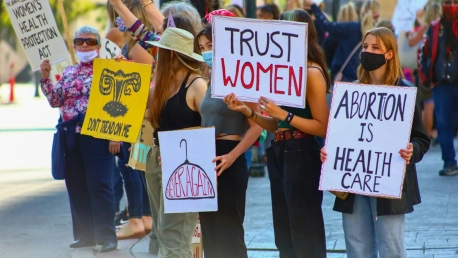The Supreme Court’s recent examination of the future of the abortion pill, mifepristone, signals a pivotal chapter in America’s ongoing narrative on reproductive rights. This scrutiny follows in the wake of shifting federal attitudes and legislation surrounding abortion access. Healthcare professionals and concerned citizens alike are waiting with bated breath, as the court’s decisions have the power to substantially alter the landscape of abortion care in the country.Access to medication abortion, especially mifepristone, has been a cornerstone of reproductive healthcare since its FDA approval in 2000. It provides a non-surgical option for terminating early pregnancies and is often touted for its privacy and autonomy. A Supreme Court ruling that restricts or upholds access to this drug will have far-reaching effects, not least on the fundamental rights of individuals seeking to make autonomous healthcare decisions.As the Supreme Court deliberates, the future of mifepristone hangs in the balance. The gravitas of their impending decision cannot be overstated, as it has the capacity to redefine the practicalities of exercising reproductive rights in the United States. Moreover, the decision is a symbol, spotlighting the evolving judicial and legislative dialogue on how healthcare and morality intersect and who gets the final say in such deeply personal medical matters.
The Supreme Court’s Scrutiny of Mifepristone
Examining the Case and Its Implications
The Supreme Court’s recent evaluation of mifepristone access signifies a critical juncture in reproductive healthcare law. With a conservative majority on the bench expressing doubt about prior restrictions on the drug, a pivotal legal shift could be imminent. The outcome of this case is likely to profoundly impact abortion procedures in the United States and could either uphold or challenge the obstacles faced by countless women seeking control over their reproductive choices.The justices’ approach to this case indicates a degree of uncertainty that may lead to a reshaping of the legal landscape regarding reproductive rights. A decision in favor of easing restrictions on mifepristone would enhance the availability of medication abortions, providing a significant boost to reproductive autonomy. Conversely, a ruling that favors existing barriers could fortify the hurdles women currently encounter when attempting to access abortion services.Whichever way the verdict sways, its repercussions will be far-reaching, affecting the precedent for future legal battles surrounding reproductive health. As the court deliberates, the nation watches closely, recognizing that the scales of justice could tilt in a direction that either empowers or further limits a woman’s right to make decisions about her own body. The final decision of the court has the potential to not only influence the immediate availability of mifepristone but also define the legal contours of reproductive freedom for years to come.
Potential Impact on Healthcare
A potential legal challenge to the availability of the abortion drug mifepristone may have sweeping effects on abortion healthcare in the United States. Should access be restricted or eliminated, it would prompt a cascade of changes across the medical community. Healthcare practitioners might need to develop revised protocols for administering medical abortions, possibly turning to less familiar or new medical methods.This shift would likely involve deep consideration of the risks concomitant with different abortion methods, particularly if the safety profile of substitute regimens differs from that of mifepristone. Medical professionals would consequently be tasked with navigating a transformed healthcare landscape, ensuring that they provide safe and effective care for patients seeking abortions, in the face of changing regulations and available resources.The full ramifications of such a ruling extend beyond immediate medical protocols to the broader social and political discourse concerning reproductive health. As the Court deliberates, the medical community, along with the public, waits to see how deeply the potential legal decisions could alter the infrastructure of abortion care and the maintenance of reproductive rights.
Political Dynamics Post-Roe v. Wade
Intensified Political Rhetoric
In the current political climate, the debate over a national abortion ban has intensified, particularly within conservative circles. Ex-President Trump leads the charge, advocating for stringent restrictions on abortion, a move that has intensified the broader conversation across the nation. This stance, however, has brought to light substantial differences within the Republican Party, as members grapple with the strategy and pace at which to advance their anti-abortion platform.The conversation around a national abortion ban is proving to be a significant factor in legislative discussions and is expected to play a crucial role in shaping campaign tactics in upcoming elections. While some conservatives are eager to forge ahead with a hardline approach, there is notable concern about potential backlash and the impact on the party’s unity. As political figures and constituents engage with this contentious issue, it illustrates the deep divide within American politics over reproductive rights, highlighting how the abortion debate continues to influence and define political landscapes.
The Role of Democrats
The defense of abortion rights has become a rallying cry for Democrats and a clear line in the sand between them and Republicans. The issue not only unites their base but also garners support from voters across the spectrum who prioritize reproductive rights. This was evident in the triumph of a Democratic candidate in Alabama, who ran primarily on the platform of preserving access to abortion. Such victories underscore the potent electoral sway of this issue.Going forward, Democrats are expected to increasingly spotlight abortion rights as a key electoral issue. They aim to use it to mobilize supporters and draw a sharp distinction with the GOP, whose members often seek to restrict such rights. As the political landscape evolves and new elections approach, the topic of reproductive freedoms promises to be a central theme in campaign strategies. Democrats will likely argue that upholding these rights is essential for gender equality and personal autonomy, thus appealing to voters for whom these are significant concerns.Their approach suggests a strategic emphasis on shaping policy discussions around the preservation of individual liberties, particularly in the context of health care and women’s rights. The Democratic Party is banking on the belief that a strong stance on abortion rights can impact voter turnout and shift electoral outcomes in their favor, an assertion reinforced by recent political events.
Legal Precedents and Future Strategies
Revisiting the Comstock Act
The Supreme Court’s review of the Comstock Act marks a significant foray into past legal conflicts that may regain prominence. This historic law, which once restricted the dissemination of abortion-related information through the postal service, could become a potent instrument in the current fight against abortion rights if it is reaffirmed. Such a decision would unearth a dormant legislative relic, imbuing it with newfound significance in the crusade to limit reproductive freedoms.Revitalizing the Comstock Act could intensify existing ideological rifts over how to navigate the contentious landscape of reproductive rights. This legal strategy could profoundly influence future policy directions, as anti-abortion advocates seek historical precedents to bolster their cause. The prospect of resurrecting a 19th-century law for 21st-century political battles emphasizes the critical role that judicial interpretation and legal maneuvering play in the ongoing debate over abortion access.As the nation grapples with these complex issues, the Supreme Court’s deliberations underscore the enduring tension between historical jurisprudence and modern societal values. The potential revival of the Comstock Act’s prohibitions is a vivid reminder that past legal frameworks continue to hold sway, offering both challenges and opportunities in shaping the trajectory of reproductive rights in America.
Trump’s Potential Return
The possibility of Donald Trump making another bid for the U.S. presidency has fueled speculation about a resurgence of older abortion laws if he were to win office again. A significant piece of legislation that might return to the forefront is the Comstock Act, a law that, while currently inactive, could become a cornerstone of a new Trump administration’s agenda to curb reproductive freedoms. Trump’s previous tenure saw conservative movements gain momentum, and his re-election could reignite those efforts, potentially re-establishing a restrictive environment for reproductive health policy.A Trump victory could herald a conservative shift in legal interpretations and legislative action regarding abortion rights. This might involve a strategic use of past legislation to impose limitations on access to reproductive health services. As the political landscape adjusts to the ramifications of such a presidential comeback, advocates for abortion rights might face significant challenges in defending and maintaining current standards for reproductive health care.The emphasis on reviving previous restrictions under a possible Trump administration underscores the ongoing debate within the United States. The legal system and legislative bodies could become battlegrounds once again, as contrasting ideologies clash over the right to abortion. This could trigger a host of legal and societal implications, affecting how reproductive rights are understood, legislated, and practiced across the nation.
Healthcare Planning Beyond Abortion
Conservative Proposals on the Table
The healthcare policy debate in the United States is evolving as conservative factions and GOP members actively develop new strategies for healthcare transformation. Central to these efforts is the Heritage Foundation, whose recent healthcare proposal exemplifies a broader plan to reimagine the healthcare system. These initiatives by conservative thinkers showcase a shift in strategy – away from the public battleground of controversial topics such as abortion, and towards a more nuanced approach to systemic change.While outwardly, there seems to be less emphasis on the nitty-gritty of healthcare, these moves signal a commitment to substantive policy reform. It is a quiet recalibration, suggesting that while overt campaigning on healthcare’s intricacies may be unpopular, the appetite for significant reform has not diminished. Behind-the-scenes work by these conservative bodies is setting the stage for a potential overhaul of how healthcare is managed and delivered, indicating that the ongoing policy conversation is anything but stagnant.This readiness to engage with the complex levers of healthcare, and propose deep-seated changes, reflects an understanding that effective reform requires thoughtful consideration and a willingness to challenge existing paradigms. The detailed proposals being crafted show a determination to tackle systemic issues, aiming to bring about efficiency, sustainability, and equity to American healthcare.
Addressing Misinformation and Unintended Consequences
Amidst the explosion of social media platforms such as TikTok, a pressing concern has emerged regarding the spread of misinformation, particularly around the topic of hormonal birth control. This trend poses a notable threat, as deceptive content circulating online can lead to a significant increase in unintended pregnancies. It highlights the growing necessity for clear, accurate health information to be distributed on these platforms.The issue transcends individual well-being, impacting broader public health, as myths and unverified claims can significantly affect decision-making around contraception use. Misconceptions about hormonal birth control methods can deter their use or encourage incorrect usage, diminishing their efficacy and resulting in preventable consequences.Combatting this misinformation is imperative. It calls for healthcare professionals, educators, and informed influencers to engage actively with these digital communities. By providing scientifically based, understandable, and accessible facts, they can rebut false narratives and educate the public about safe contraceptive options. The strategy should involve collaborative efforts that include content creation, interactive discussions, and leveraging the virality of social media to disseminate trustworthy health information. Ensuring that evidence-based information is more prominent than misleading content is a significant step toward safeguarding public health. The potential fallout from the spread of false information around birth control necessitates a coordinated response to uphold reproductive health standards and mitigate the risk of a rise in unintended pregnancies driven by digital misinformation.
Broader Health Policy Considerations
Medicare’s Unanticipated Challenges
The ongoing discourse on Medicare reveals its deficiencies, including unexpected financial challenges for beneficiaries. Despite the program’s intent, it falls short by presenting beneficiaries with numerous out-of-pocket expenses and complex rules that complicate access to necessary care. These obstacles highlight the system’s inadequacies and emphasize the need for a thorough assessment. Recipients often contend with a labyrinth of instructions that can lead to unforeseen costs, which are a significant burden on a demographic typically reliant on fixed incomes. The intricacies of Medicare’s coverage, co-pays, deductibles, and the need for supplementary insurance underscore the unforeseen financial strain on enrollees. As beneficiaries navigate these financial complexities, the imperative for reform becomes clear. Policymakers are called upon to revamp Medicare, seeking innovative solutions to refine the system, enhance its comprehensiveness, and lift the financial weight from the shoulders of seniors and others dependent on the program. This assessment continues to fuel discussions around Medicare reform, with the goal of not only streamlining the program but also ensuring it fully addresses the healthcare needs of its users.
The Price of Emergency Healthcare
The hefty expenses linked to air-ambulance services are indicative of a broader problem in healthcare: the cost barrier faced by patients in crisis situations. Emergency air transport can leave patients with substantial financial burdens, underscoring an urgent need for health policy reforms. It’s crucial that reforms address the all-too-common scenario where life-saving services, although technically within reach, become financial nightmares for those they’re meant to help.This situation demands a careful balance in policymaking, wherein the sustainability of air-ambulance services is maintained, while also safeguarding patients from falling into debt due to their use. These services, often essential in time-sensitive or remote situations, should not lead to financial ruin. Questions of who bears the cost and how these services can be equitably integrated into healthcare systems are at the forefront of the debate.Addressing air-ambulance costs touches on larger themes of insurance coverage limits, surprise billing practices, and the gaps within healthcare networks. Solving this problem requires a multifaceted approach that could include stronger regulations on price transparency, caps on out-of-pocket costs for patients, and better coverage policies from insurance providers. It’s a complex challenge with life-or-death implications, testing our commitment to not only preserving life but also protecting patients from the economic aftermath of emergency care.









